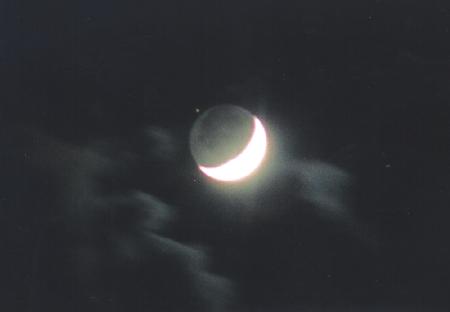SKYLIGHTS

Photo of the Week.. The crescent Moon takes a bead on
Eta Geminorum, ready to pass over, or occult it.
Astronomy news for the short week starting Sunday, January 13, 2002.
The Moon passes between the Earth and the Sun in its new phase on
Sunday, January 13, and all we can see is the dark nighttime side.
By the night of Monday, the 14th, the slim lunar crescent will be
visible in evening twilight, its nighttime side lit with light
reflected from the Earth. If you were on the Moon, you would see
an almost-full Earth. Given that the Earth is both four times the
size of the Moon and that it is much more reflective, the night on
the Moon under full-Earth is 80 times brighter than the earthly
night under the full Moon. That same night, the 14th, the Moon
will lie 4 or so degrees south of the planet Mercury and might help
guide your eye to the little planet closest to the Sun.
The SECOND planet out, Venus, has been invisible for some time now,
as it makes its circuit around the other side of the Sun. On
Monday the 14th -- a busy day -- Venus passes through superior
conjunction, the Earth, Sun, and Venus more or less lined up in
that order and Venus at her greatest distance from us (some 255
million kilometers, 160 million miles). Venus will then slowly
begin to clear the Sun as it prepares for evening visibility. By
March, Venus may be seen setting in mid-evening twilight, and this
coming summer will make a glorious evening spectacle of itself.
With Mars still in the southwestern sky, Jupiter (beautifully set
in Gemini) passes the celestial
meridian just before midnight and nearly overhead in northern
climes. Saturn, close to the Hyades in Taurus,
beats Jupiter to this north-south line, crossing the meridian
around 9:30 PM. Still in retrograde, Saturn will get even closer
to this vee-shaped cluster, the Hyades and the planet presenting a
very attractive sight by the end of the month.
The winter stars are now in full array. Look high in the sky
around 8 PM to find the compact cluster of the Pleiades. Compact it may seem,
but it is still so spread out that the telescope does not show it
all that well -- best to use binoculars. With either, hundreds of
the Seven Sisters' cousins will pop out for you. Vast numbers of
clusters dot the sky. Look to the central star of Orion's sword and admire the famed
Orion Nebula. Within it is one of the sky's richest star clusters,
topped by the 4-star "Trapezium" that lights the nebula, most of
the clusters stars lost to the nebular glow. The Orion Nebula is
a blister on the front edge of a vast dark molecular cloud in which
star formation is going on even as we watch.







